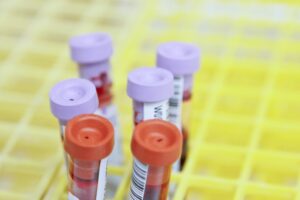
Written by Dr. Diane Mueller
The western blot test is a test that is used to detect and analyze proteins. It involves a process that transfers proteins to a membrane where the individual proteins can be seen. Proteins on the western blot appear as “bands”. This is part of the testing methodology that is used for diagnosis of Lyme Disease. It is a blood test that looks for antigens (proteins) of Borrelia (bacteria that causes Lyme) and our immune response to these proteins.
There are two main challenges with this test.
Firstly: Conventional standards say not to order this test until a positive Lyme test is found using a different type of testing methodology known as the Elisa. The problem with the Elisa test is that it has a 66 percent chance of a false negative. If you fall in this 66%, then the follow up test, the Western Blot, will likely not be ordered. (To learn more about this see our blog called Lyme Disease Test.)

The other problem with the western blot comes down to interpretation. The bands that were mentioned above are analyzed in order to determine if the western blot is positive for negative.
Sensitivity and Specificity of the Western Blot Test Lyme
Sensitivity and specificity are laboratory terms. Sensitivity speaks to how sensitive the test is to pick up a positive value if the test is positive. Specificity is a measure of how specific the test is. If something is very high specificity, it means that almost no other disease will trigger a positive except for the disease that is being tested for. Low specificity means that many other disease processes could trigger a positive besides the disease that is being tested for.
When we speak of the bands that are tested for in the Western Blot Lyme test, some of the bands are highly specific and sensitive. Others have a lower amount of specificity. Interpreting this test involves an understanding of which bands are the most sensitive and specific for the microorganism Borrelia (the bacteria that causes Lyme Disease).
We are still learning in research which bands are most sensitive and specific for Borrelia.
Some highly specific bands include: 83-93, 34, 39, 23-25
Some highly sensitive bands include 31 and 41.
The bands 31 and 41 will show up in many of the cases of Lyme disease (hence sensitivity) but some viruses also have these proteins, making them non specific.
Keep in mind at our medical clinic that many people have been told they do not have Lyme Disease, when proper testing and interpretation show that they actually do have Lyme.
The interpretation of the western blot involves in part understanding which bands are specific and which are not. The CDC recommends the following for interpreting the Western Blot:
If it is an IgM antibody response to the bands, then 2 of the following three bands are required for a positive test.: OspC (21-25), 39 and 41.
If it is an IgG antibody response to the bands then 5 of the following ten bands are required for a positive test: 18, OspC (21-25), 28, 30, 39, 41, 45, 58, 66 and 93.
There are several problems with this standard diagnostic
criterion. Firstly, these testing criteria was developed in the early 1990s based upon looking at dozens (just dozens, not that high of a number) and seeing correlation of which bands showed up most often in people that had Lyme Disease symptoms. Firstly, we know so much more about Lyme disease and big symptom picture that it creates. Therefore, adaptation of how we diagnose Lyme is based upon old observational data from the early 1990s and nothing more.
Secondly, this criterion mentioned above, does not consider that some bands are much more specific than others. The argument is that since 23-25, 34, 39 and 83-93 are very specific to Lyme (other things do not flag a positive), why do we say that someone must have 5 of them in the IgG case listed above to be positive. Furthermore, 34 is tested for and not even listed in the diagnostic criteria despite it being very specific to Lyme Disease.[1]
And perhaps the biggest problem of all of this, is that we western
blot look for an immune response to the proteins (bands) of Borrelia. In long term and late stage Lyme Disease, Borrelia can have suppressed the immune
response. Without a proper immune response, a positive test can look negative. And
finally, a western blot can show positive even long after treatment is completed, and the individual has recovered from Lyme Disease. Therefore, it is not the
best test to determine if the infection is still active or not.
This all being said, the western blot is still a useful tool for determining if Lyme Disease is positive. It needs to be interpreted according to an overarching understanding of what it can tell us and in terms of what its limitations are. This is why working with a Lyme Literate doctor who has studied material like this is super essential. It is also why using testing companies that combine a variety of lab testing techniques can be helpful as this provides additional data to help make the diagnosis. To learn more about different types of Lyme Disease Tests besides the Western Blot, see our blog: Lyme Disease Test.
[1] [2] Dressler F, Whalen JA, Reinhardt BN, Steere AC. Western blotting in the serodiagnosis
We have helped thousands of
people restore their health
and quality of life by diagnosing
and treating their Lyme Disease.
“Dr. Mueller’s approach to medicine is refreshing! There is only so much you can do with western medicine and in my life I was needing a new approach. By addressing the whole body, nutritional diet factors, environmental factors, blood work, and incorporating ideas I had not previously known, I was able to break through with my conditions. I am not only experiencing less pain in my life, but through the process of healing guided by Dr. Diane Mueller, I am now happy to say I have more consciousness surrounding how I eat, what to eat and when things are appropriate. Living by example Dr. Mueller has a vibrancy that makes you want to learn and know more about your body and overall health. I highly recommend her to anyone looking for new answers, a new approach to health, or in need of freedom from pain and limitations.”
-Storie S.
Kihei, HI
